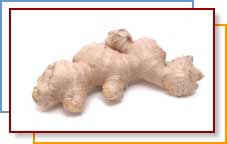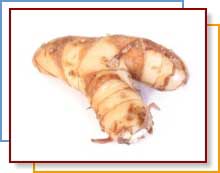
Rhizomes are knobby underground stems that are known for their pungent
and flavorful flesh. The rhizome family includes ginger, turmeric and
galangal among a few other, lesser known rhizomes. Rhizomes are not a
significant source of any nutrients – most especially because they are
rarely eaten in great enough quantities to constitute a serving. Ginger is
a tropical Asian herb that is known for its spicy aromatic roots. In
ancient India, ginger was believed to spiritually cleanse the body.
| |
|
Ginger |
Serving Size
1 tablespoon, raw (6g)
|
Amounts
Per Serving |
% Daily
Value |
| Calories 5 |
|
| Calories from Fat 0g |
|
| Total Fat
0g |
0% |
|
Saturated Fat 0g |
0% |
| Sodium
0mg |
0% |
| Total
Carbohydrate 1g |
0% |
| Dietary
Fiber 0g |
0% |
| Sugars
0g |
|
| Protein 0g |
|
| Vitamin
A |
0% |
| Vitamin C |
0% |
| Calcium |
0% |
| Iron |
0% |
* Percent Daily Values are based on a
2,000 calorie diet.
|
|
| |
|
It was also used in ancient times as a food preservative and to help
treat digestive problems. To treat digestive problems, Greeks would eat
ginger wrapped in bread. Eventually ginger was added to the bread dough
creating that wonderful treat many around the globe love today:
gingerbread!
Ginger ale eventually stemmed from a ginger beer made by the English and
Colonial America as a remedy for diarrhea, nausea and vomiting.
Ginger thrives in the tropics and warmer regions and is therefore
currently grown in parts of West Africa, the West Indies, India and China
with the best quality ginger coming from Jamaica where it is most
abundant. In the United States, ginger is grown in Florida, Hawaii, and along the
eastern coast of Texas.
Gingerroot is characterized by it’s strong sweet, yet woodsy smell. It
is tan in color with white to creamy-yellow flesh that can be coarse yet
stringy.
| |
|
Galangal |
Serving Size
1 tablespoon, cooked (8g)
|
Amounts
Per Serving |
% Daily
Value |
| Calories 5 |
|
| Calories from Fat
0g |
|
| Total Fat
0g |
0% |
|
Saturated Fat 0g |
0% |
| Sodium
0mg |
0% |
| Total
Carbohydrate 0g |
0% |
| Dietary
Fiber 0g |
8% |
| Sugars
0g |
|
| Protein 0g |
|
| Vitamin
A |
0% |
| Vitamin C |
0% |
| Calcium |
0% |
| Iron |
0% |
* Percent Daily Values are based on a
2,000 calorie diet.
|
|
| |
|
Galangal (guh-LANG-gul) comes from the plant Alpinia galanga (or
Languas galangal) and has many common names including greater
galangal, galangale, and galang.
The rhizome (root) of galangal resembles ginger in taste and appearance.
It is predominantly found in Asian markets and sold fresh, frozen, dried,
or powdered. Galangal is also well known in European medieval cooking.
Only a pinch of dried and powdered versions are typically needed.
Galangal is frequently used in fish and shellfish recipes in combination
with garlic, ginger, chilli, and lemon.
Greater Galangal: Orange-brown skin with pale yellow or white
interior. Greater galangal can be found in sliced form or powder. Used as a
flavoring throughout Indonesia, Malaysia, and parts of India.
Flavor: Not as pungent as lesser galangal.
Lesser Galangal: This rhizome has a red-brown interior and fibrous
texture. It can be founded as slices or powder. Lesser galangal comes from
China where it is used as a medicinal herb, but it is now grown in Indonesia
and regarded as a spice.
Flavor: Aromatic and pungent, peppery and ginger-like. Stronger, more
medicinal taste than greater galangal.
Kaempferia Galangal: Often identified as greater galangal. Red skin
and white interior. Used as a flavoring in South East Asia.
Flavor: Medium in strength.
Different galangal varieties vary in their hotness and flavor. Flavor
ranges from flowery to ginger-like to peppery cinnamon (see box below).
In addition to being used as a spice in cooking, galangal has been used in
Asia and the Middle East in perfumes, snuffs, aphrodisiacs, and as flavors
for condiments (including vinegar and beer), in teas in Germany and wines in
Russia. Like ginger, galangal has been used for medicinal purposes to treat
nausea, flatulence, and dyspepsia.
Tumeric is the root of a tropical plant that has been used in cooking
since 600 B.C. It is native to the Orient and now can be found in India and
the Caribbean. It has a bitter, pungent almost woodsy flavor, is
yellowish-orange in color.
The tumeric root has light brown skin and bright reddish-orange flesh.
Turmeric was used in biblical times as a perfume but now it is most commonly
used to flavor and color food. Ground turmeric is widely used in East Indian
cooking particularly in curries as well as other soups and stews.
Rhizomes can be found as roots in some Asian grocery stores, farmers
markets and natural food stores (gingerroot can even be found in many chain
grocery stores). In spice form, ginger and tumeric can be found in almost
any food store.
Galangal
When ripe, galangal should be ivory white and firm with very little
separation between skin and flesh. Never buy galangal that is wrinkled or
shriveled. Store refrigerated uncut and unwrapped for up to 3 weeks or, peel
the root and place it in a jar of sherry and store it refrigerated for
several months. Galangal can be frozen if tightly wrapped in foil.
Ginger
Ginger is available year-round. When selecting gingerroot, choose robust
firm roots with a spicy fragrance and smooth skin. Gingerroot should not be
cracked or withered. It can be stored tightly wrapped in a paper towel or
plastic wrap (or put into a plastic bag) in the refrigerator for 2–3 weeks
and like galangal, gingerroot can also be placed in a jar of sherry and
refrigerated for 3–6 months.
Tumeric
Fresh tumeric roots should have a spicy fragrance and stubby fingers
protruding from the sides of the root. Refrigerate unpeeled tumeric, tightly
wrapped, for 3 weeks.
Galangal
Galangal can be sliced and used to flavor soups and stews (remove before
serving). It can also be mixed with lemon grass, chilies, shallots and
garlic into a paste that can be used to flavor rice dishes. Galangal can
also be mixed into a curry paste for similar purposes.
Ginger
Peel skin from the root and gently peel the skin beneath (that closest to
the root is the most flavorful). Gingerroot can be sliced or minced (minced
gingerroot gives the most pungent flavor). Ginger is popular in Asian
cuisine where it is used both fresh and dried. Ginger can also be found
crystallized, candied, preserved and pickled.
The powdered, dried form of ginger has a more spicy, intense flavor and is
often used in baking (gingerbread, gingersnaps, ginger cookies).
Tumeric
Tumeric is typically boiled or steamed and then dried and ground into
powder. Use ground tumeric in fish or rice dishes. Be careful with fresh
turmeric, it will stain your hands and clothing.
Saffron (very expensive) is sometimes substituted for tumeric.
Recipes

Spiced Cabbage
Makes 4 servings
Each serving equals 1/2 cup of fruit or vegetables
Ingredients
half a medium cabbage
1 small onion (or half a medium one)
1 hot green chili pepper
1 Tbsp coconut
½ tsp. turmeric powder
2 cm piece of fresh root ginger
spray oil
Shred the cabbage very finely and chop into small pieces. Finely chop
the onion, chilli and ginger. Spray frying pan with spray oil. Add the
onion, ginger and chilli. Cook for 30 seconds then add the cabbage and
turmeric. Cook at a high temperature for about ten minutes stirring all
the time. Remove the pan from the heat and stir in the coconut. This dish
can be served on it's own but can also accompany many different rice
dishes.
Nutritional analysis per serving: Calories 58, Protein 2g, Fat 1g,
Calories From Fat 22%, Cholesterol 0mg, Carbohydrates 11g, Fiber 4g, Sodium
36mg.

Find more in our
recipe database!
|



